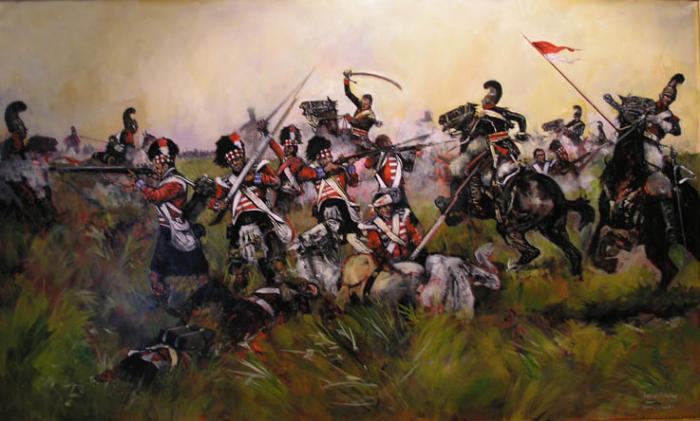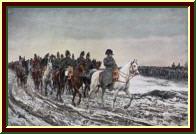

If you think of any artists that should be included here, please let The Sharpe Compendium know. We'll be happy to add them.Recommended Artists Check back often to see what's new!
Born in Edinburgh, Allan attended the Drawing Academy established in Edinburgh by the Board of Trustees for Arts and Manufactures with Sir David Wilkie (1785 - 1841) and then completed his training in London. Allen took to traveling the world beginning in 1805, first to Prussia and St. Petersburg, where he painted for the Russian nobility, on to the Ukraine, Crimea and the Caucasus in 1807, painting as he went. Returning home in 1814, Allan set up a studio in Edinburgh, yet continued to paint scenes from Russian life, making use of a large number of artifacts he had brought back, in addition to Scottish historical paintings. Alan is known for the detail and scale of his work and his often exotic subject matter and did much to establish the Victorian proclivity for grand historical themes, becoming a key figure in Scottish art through the first half of the 19th Century.
Continuing his worldly travels, in 1830 he visited Italy and Turkey, producing his famed "Constantinople Slave Market". He visited Spain and Morocco in 1834 and returned to St. Petersburg in 1841, and, accepting a commission from the Tsar, he produced "Peter the Great Teaching his Subjects the Art of Shipbuilding". Allan's Russian works can also be seen today in the great Hermitage Museum in St. Petersburg. His two Waterloo paintings were painted during a brief period in the 1840s when he concentrated on depictions of the Napoleonic War.
In 1835, Allan was elected to the Royal Academy in London. He served as President of the Royal Scottish Academy from 1838 and Queen's Limner in Scotland from 1841. He was knighted in 1842 and died in 1850.
Born in South Africa, Jason Askew attended the Johannesburg School of Art, Ballet and Music, followed by the City and Guilds of London Art College, Kennington. His education in the history of South Africa sparked his interest in military history, particularly the Zulu and South African wars, which gave him the inspiration for his first major epic series of the Zulu War. By law, Jason was required to perform national service which allowed him a choice of going into the Armed Forces or the National Police Force; Jason chose the police. In South Africa, the police have always borne the brunt of the civil unrest, and continuing high level of violent crime (average of 19000 murders per year for the last ten years), causing the training and service of police to be very similar to that for the Armed Forces. He was based at Hillbrow (the Bronx of Johannesburg) and also served with the SAPS Flying Squad. From his witnessing of the effects of civil combat first hand, particularly in the brutal, sometimes hand-to-hand fighting that is so often found in South African situations, Jason was motivated to paint his experiences, producing a body of work that demonstrates his commitment to his art. All the experiences that he had in the SAPS directly inform his paintings.
Jason has had numerous commissions from many British and overseas regiments: 2RGR The Gurkhas, The Queens Lancashire Regiment, the Coldstream Guards, the Staffordshire Regiment to name a few. He was also designated Official War Artist for the Staffordshire Regiment in Iraq. Cranston Fine Arts are proud to be publishing a majority of Jason's art prints since 2005 and are planning a major series of releases which they have commissioned, including an outstanding series of eight First World War battle scenes of many of the major Western Front battles. This series started in 2007 finished in 2008. Also included is a series of four Battle of Waterloo and four Zulu War limited editions, all specially priced for collectors.
"I never lose sight of the fact that real people are often caught in the middle of conflicts that are created by politicians/governments/reasons beyond the control of individuals, yet it is always individuals that suffer." ~Jason Askew
http://www.yessy.com/jasonaskew/
https://www.facebook.com/pages/Jason-Askew-Historical-and-Military-Art/160413370645242
James de Vine Aylward was born in England some time in the second half of the 1800s, believed to be 1871. He was a painter of genre scenes and most notably, of interior genre scenes. He was reported as living part of his life in Liverpool and in London.
While little is known about the life of Aylward, it is reported that during the period of 1895 through 1917, he exhibited quite often and successfully at major art venues, including the Royal Academy, London ( nine paintings), The Walker Gallery, Liverpool (33 paintings), The Royal Society of British Artists, London ( two paintings), The Royal Institute of Oil Painters, London( 15 paintings) as well as The Royal Miniature Society, The Royal Institute of Painters in Water Colors and The Manchester City Art Gallery. Perhaps his most celebrated painting is the iconic Wellington and the Rifleman scene "Morning Before Waterloo".
He is believed to have died in 1966.
Elizabeth Thompson was born in Lausanne Switzerland in 1846. The oldest of two daughters of Thomas James Thompson and his second wife Christiana Weller, an amateur artist. and Elizabeth showed an interest in drawing at the age of five. The family spent their summers in the Italian Riviera and the children were home schooled. Having shown an interest in drawing at the age of five and a childhood of homeschooling, she took formal studies in England the family returned to Italy where Elizabeth began study with Giuseppe Bellucci in Florence in 1869. By 1870 she was painting religious subjects and portraits of friends. She also sketched in pen and pencil and watercolor. Her sketches were mostly soldiers and men in battle.
Elizabeth submitted the painting Roll Call to the Royal Academy in 1874 and almost overnight she became a much sought after artist. The painting became a huge success for the young painter with critics and the public alike and due to its popularity the Academy sent it on tour. Much sought after by collectors, the painting was eventually purchased by Queen Victoria who allowed engravings of the image and prints were sold to the public. Continuing to paint military subjects to great acclaim, Elizabeth made sure her paintings were as accurate as possible. Because of her fame and success many of the men who had taken place in the battles she depicted would pose for her paintings in their uniforms.
John Ruskin, who had proclaimed he thought no woman was capable of painting to a professional level, publicly recanted his statement after viewing Elizabeth's work. Her paintings were not just action scenes of battles but focused on the human elements of suffering and bravery and the individuals taking part in the conflict. Her work changed the view of women painters and the idea of what military paintings should be about.
In 1877 Elizabeth married Major William Butler, producing six children, traveling with her husband through Africa, the Middle East and Europe as he carried out his military service. After the Boer Wars (1880-81 and 1899-1902) the interest in military painting dwindled and though Elizabeth continued to paint, twentieth century taste turned away from realism to modernism. Elizabeth Thompson Butler died in 1933 at the age of 87.
I never painted for the glory of war, but to portray its pathos and heroism.
~ Lady Elizabeth Butler A Dictionary of European Genre Painting, Phillip Hook and Mark Poltimore, The Antique Collectors Club 1986
Lady Butler, Battle Artist 1846-1933, Paul Usherwood and Jenny Spencer Smith, Sutton publishing LTD 1987
An Autobiography By Elizabeth Butler, Constable & Co. LTD 1922
Ansdell was born in Liverpool, Lancashire, the son of Thomas Griffiths Ansdell, a freeman who worked at the port, and Anne Jackson. His father died young and Richard was educated at the Bluecoat school for orphans. He had a natural talent for art from an early age, and after leaving school worked for a portrait painter in Chatham in Kent, and also spent time as a sign painter in the Netherlands.
He first exhibited at the Liverpool Academy in 1835, becoming a student there the following year. His animal and rural subjects proved to be popular and he soon attracted wealthy patrons. His first exhibition at the Royal Academy, London, was in 1840. He went on to exhibit pictures every year at the Academy until 1885 (149 canvases in all). In 1846 he exhibited his first picture, "A Drover's Halt" at the British Institution, London, and went on to show 30 canvases there.
In June 1841, he married Maria Romer - the couple went on to have 11 children. In 1847 the family left Liverpool to live in Kensington in London.
In 1850, Ansdell started collaborating on pictures with Thomas Creswick, who specialised in landscapes. He also worked with William Powell Frith ("The Keeper's daughter") and John Phillip, with whom he travelled to Spain in 1856 and painted a series of Spanish subjects - "The Water Carrier", "The Road to Seville", "The Spanish shepherd" etc. He returned to Spain alone the following year to paint more pictures there.
Ansdell's best known works include Stag at Bay (1846), The Combat (1847), and Battle of the Standard (1848) - depicting the capture of the French flag at Waterloo by Sergeant Ewart of the Scots Greys.
During part of his career he kept a "summer house" at Lytham St Annes, in the borough of Fylde, where a district, Ansdell, is named after him. He is the only English artist to have been honoured in this way. Ansdell died at "Collingwood Tower" near Frimley, Surrey in April 1885. He was buried at Brookwood Cemetery.
Baker was born in Pune in India to a member of the British East India Company. After the family returned to Britain, he was educated at Winchester College and the Military Academy at Dresden, followed by service in the 21st Hussar regiment in India and Burma. He fought with the 9th Royal Prussian Hussar regiment during the Boer Wars in South Africa in 1900. In the First World War, he became a Lieutenant-Colonel and commanded a battalion of the Yorkshire Regiment, earning a Distinguished Service Order medal in 1918.
Baker is known for his illustrations and watercolor paintings of military subjects, his most well-known being "Sir John Moore at Corunna, January 16th 1809" painted in the 1920s. He exhibited his paintings at the Liverpool Walker Art Gallery and London Salon between 1914 and 1930, as well as in his home town of Beccles.
Besides his artwork, Baker wrote and illustrated a number of books, which included the titles "From a Terrace in Prague" and "A Winter Holiday in Portugal". He also served as Justice of the Peace for Suffolk and was elected a Fellow of the Royal Geographical Society and of the Royal Historical Society. Baker died in Beccles in 1957.
 | ||||||
 |
 |
 |
 |
 | ||
|
| ||||||